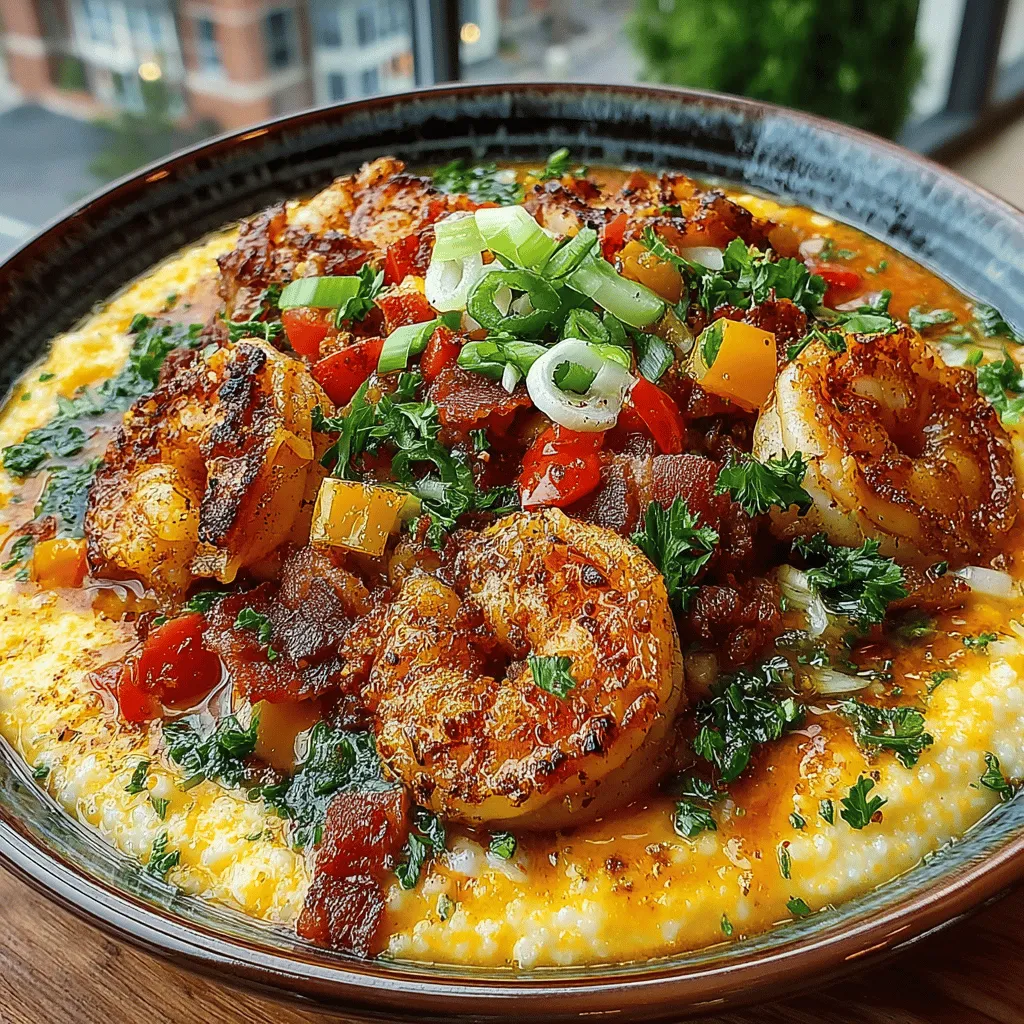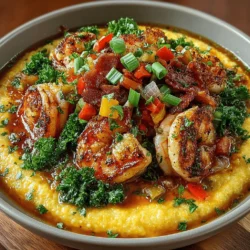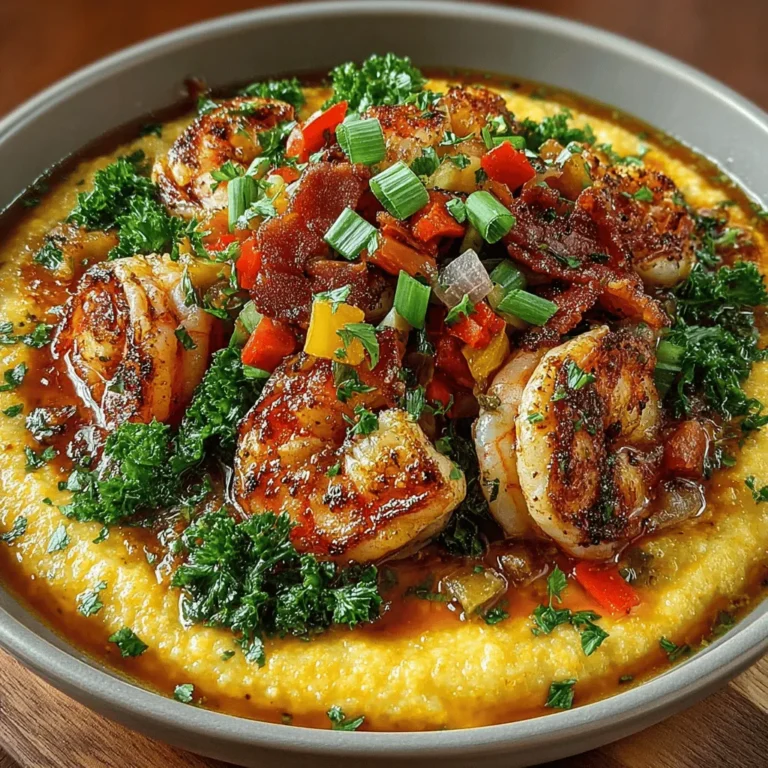Southern Comfort: Classic Shrimp & Grits Recipe
Shrimp and grits is a quintessential Southern dish that embodies comfort, warmth, and culinary tradition. Originating from the coastal regions of the Southern United States, this dish has transcended its humble beginnings to become a beloved staple on menus across the nation. The combination of succulent shrimp and creamy grits serves not only as a meal but also as a celebration of Southern heritage and hospitality.
Historically, shrimp and grits can be traced back to the Lowcountry of South Carolina, where it was initially a simple breakfast dish for fishermen. As time went on, it evolved into a versatile meal enjoyed at any time of day. The dish reflects the cultural melting pot of the South, incorporating influences from Native American, African, and European cuisines. Today, shrimp and grits are often associated with the comfort food category, celebrated for their rich flavors and satisfying textures.
In contemporary cuisine, shrimp and grits have gained immense popularity in both home kitchens and fine dining establishments. Chefs have reimagined this classic dish, experimenting with various ingredients and techniques while still honoring its roots. Whether served at a family gathering or a gourmet restaurant, shrimp and grits evoke a sense of nostalgia and comfort that resonates with many.
Understanding the Ingredients
To create a truly authentic shrimp and grits dish, it’s essential to understand the key ingredients that contribute to its signature flavor and texture.
Stone-Ground Grits
At the heart of this dish are the grits, which serve as a creamy base for the shrimp. For an authentic experience, using stone-ground grits is crucial. Unlike quick-cooking varieties, stone-ground grits retain their texture and flavor, providing a hearty and satisfying component to the meal. These grits are made from whole corn kernels and are ground in a way that preserves the natural oils and flavors, resulting in a richer taste.
Cheddar Cheese
Cheddar cheese plays a pivotal role in enhancing the flavor profile of the grits. The sharpness of the cheese complements the sweetness of the shrimp, creating a delightful balance. When melted into the grits, it adds creaminess and depth, making each bite more indulgent. Opting for high-quality cheddar can elevate your dish significantly, so consider using aged or extra-sharp varieties.
Shrimp Selection
When it comes to the shrimp, freshness is key. If possible, choose fresh shrimp that are sustainably sourced for the best flavor and texture. Look for shrimp with a firm texture and a pleasant, briny smell. While frozen shrimp can be a convenient alternative, they may lack the same depth of flavor. If using frozen shrimp, ensure they are properly thawed before cooking to maintain their quality.
Bacon
Bacon is not just a flavorful addition; it contributes a depth of richness to the dish. The drippings rendered from cooking the bacon can be used to sauté the shrimp and vegetables, infusing them with a smoky, savory taste that elevates the overall experience. The crispy texture of the bacon also adds a satisfying crunch, contrasting beautifully with the creamy grits.
Vegetables and Seasonings
To complement the shrimp and grits, a mix of sautéed vegetables and seasonings is often included. Common additions include bell peppers, onions, and garlic, which provide aromatic depth. Fresh herbs such as parsley or green onions can be sprinkled on top for a burst of color and freshness. Seasoning is critical; a blend of salt, pepper, and a hint of cayenne can enhance the dish without overpowering the natural flavors.
Preparing the Grits
Now that we have a solid understanding of the ingredients, let’s dive into the first crucial step of preparing shrimp and grits: cooking the grits.
1. Gather Your Ingredients
To prepare stone-ground grits, you’ll need:
– 1 cup stone-ground grits
– 4 cups water or chicken broth (for added flavor)
– Salt to taste
– 1 cup shredded sharp cheddar cheese
– Optional: a splash of heavy cream or butter for extra richness
2. Boil the Liquid
In a large saucepan, bring the water or chicken broth to a rolling boil over medium-high heat. If you prefer a richer flavor, using chicken broth is highly recommended.
3. Add the Grits
Once the liquid is boiling, slowly whisk in the stone-ground grits. This step is crucial to prevent clumping. Stir continuously for a few minutes until the mixture is well combined.
4. Simmer and Stir
Reduce the heat to low and cover the saucepan, allowing the grits to simmer. Stir occasionally to prevent sticking and ensure even cooking. Cook the grits for about 20-25 minutes, or until they are tender and have absorbed most of the liquid.
5. Achieve Creaminess
Once the grits are cooked, remove them from the heat and stir in the shredded cheddar cheese. If you prefer an extra creamy texture, consider adding a splash of heavy cream or a pat of butter. This will enrich the grits and make them velvety smooth.
6. Season to Taste
Season the grits with salt and pepper according to your preference. Taste and adjust the seasoning as needed. Keeping the grits warm is important, so you can cover the saucepan and set it aside while you prepare the shrimp.
7. Serving Options
Grits can be served in a bowl or on a plate, creating a cozy base for the shrimp. For a delightful presentation, consider garnishing with chopped herbs or a sprinkle of extra cheese.
In the next section of the article, we will focus on cooking the shrimp and vegetables, detailing the step-by-step instructions that will elevate your shrimp and grits to a new level of flavor and satisfaction.

Techniques for Sautéing Vegetables to Retain Texture and Flavor
Sautéing vegetables is a fundamental technique in cooking that can elevate the flavor profile of any dish, particularly in Southern cuisine. When preparing the holy trinity of Southern cooking—bell peppers, onions, and celery—it’s essential to retain their texture and flavor. Here are some effective sautéing techniques to achieve this:
1. Choose the Right Temperature: Start with a medium-high heat to ensure quick cooking. If the heat is too low, the vegetables will steam rather than sauté, resulting in a mushy texture.
2. Use a Good Quality Oil: Olive oil or butter are excellent choices for sautéing, as they impart rich flavors. Ensure the oil is hot before adding the vegetables to achieve a nice sear.
3. Cut Uniformly: Chop your vegetables into uniformly sized pieces. This ensures they cook evenly. Smaller pieces will caramelize faster, while larger chunks will retain a bit of bite.
4. Don’t Overcrowd the Pan: Cooking in batches if necessary allows each piece to have enough contact with the pan, promoting even cooking and preventing steaming.
5. Season Early: Season your vegetables with salt as they start to cook. This helps draw out moisture and enhances the overall flavor.
By mastering these techniques, your sautéed vegetables will contribute a delightful crunch and burst of flavor to your Shrimp & Grits.
Tips on Cooking Shrimp to Achieve the Perfect Doneness
Cooking shrimp can be tricky, but with the right techniques, you can achieve perfectly cooked shrimp every time. Here are some tips:
1. Choose Fresh Shrimp: Freshness is key. Look for shrimp that have a mild, ocean-like scent. Avoid those that smell overly fishy.
2. Peel and Devein: For the best texture, peel and devein your shrimp before cooking. This not only makes them easier to eat but also allows the flavors to penetrate better.
3. Cook in Batches: If you have a large quantity of shrimp, cook them in batches to prevent overcrowding. This ensures even cooking and browning.
4. Timing is Everything: Shrimp cook very quickly, usually in 2-3 minutes per side. They are done when they turn pink and opaque. Overcooking shrimp results in a rubbery texture.
Signs of Perfectly Cooked Shrimp
To ensure you’ve cooked your shrimp perfectly, look for the following signs:
– Color Change: Raw shrimp are gray and translucent. When cooked, they turn a vibrant pink.
– Shape: Perfectly cooked shrimp will curl into a ‘C’ shape. If they curl into an ‘O,’ they are likely overcooked.
– Opaque Flesh: Cooked shrimp will appear opaque, losing their translucence.
Incorporating tomatoes and lemon juice in the sautéing process adds a layer of freshness and acidity, balancing the richness of the grits and shrimp. The acidity enhances the dish, cutting through the creaminess and complementing the shrimp’s natural sweetness.
Plating and Presentation
The visual appeal of your Shrimp & Grits can enhance the dining experience. Here are some serving suggestions to make your dish stand out:
1. Layering the Plate: Start with a generous scoop of creamy grits as the base. Top with the sautéed shrimp and vegetable mixture, allowing the shrimp to nestle into the grits.
2. Garnishing: Fresh green onions and parsley not only add a pop of color but also a refreshing flavor contrast. Sprinkle them generously on top for an inviting presentation.
3. Drizzle with Sauce: If you have a flavorful sauce from the sautéed shrimp, drizzle it around the plate for an artistic touch.
Ideas for Side Dishes that Pair Well with Shrimp & Grits
While Shrimp & Grits can be a complete meal on their own, consider these side dishes to complement the flavors:
– Collard Greens: A traditional Southern side that adds a nutritious, hearty element.
– Cornbread: Sweet or savory cornbread pairs well with the dish, providing a delightful texture contrast.
– Fried Green Tomatoes: Their tartness and crunch make a perfect accompaniment to the creamy grits.
Variations and Customizations
One of the beauties of Shrimp & Grits is its versatility. Here are some popular variations and customizations to consider:
1. Protein Swaps: While shrimp is classic, consider substituting scallops or fish like catfish for a different take on the dish.
2. Vegetarian Adaptations: For those avoiding seafood, swap the shrimp for sautéed mushrooms or a medley of seasonal vegetables. Add plant-based cheese to keep the creamy texture.
3. Adding Heat: For spice lovers, incorporate different hot sauces or spices. Cajun seasoning can provide a rustic kick, while fresh jalapeños add a vibrant flair.
4. Cheese Choices: While cheddar is traditional, feel free to experiment with other cheeses. Gouda or pepper jack can add depth and unique flavors to the grits.
5. Flavor Enhancements: Consider adding herbs like thyme or basil into the sauté for an aromatic touch, or include a splash of white wine for an elegant finish.
Nutritional Information
Understanding the nutritional content of your meal is essential, especially in a dish like Shrimp & Grits that balances indulgence with nutrition. Here’s a breakdown of the nutritional content per serving:
– Calories: Approximately 500-600 calories per serving, depending on the amount of cheese and butter used.
– Protein: Shrimp is an excellent source of lean protein, with about 20 grams per serving.
– Carbohydrates: Grits provide a good source of carbohydrates, around 30-40 grams.
– Fat: Healthy fats from olive oil or butter contribute to the overall richness, approximately 15-20 grams.
When preparing this dish, consider dietary restrictions. For gluten-free needs, ensure that the grits are labeled gluten-free. You can also substitute dairy cheese with plant-based alternatives for a lactose-free option.
Conclusion
Shrimp & Grits is more than just a dish; it’s a comforting embrace of Southern cuisine that brings warmth to any dining table. With its creamy grits and succulent shrimp, it embodies the essence of home-cooked meals.
Encouraging you to try this recipe is an invitation to indulge in a culinary experience that highlights the richness of Southern flavors. Remember, the magic of Shrimp & Grits lies in its versatility; whether you stick to the classic recipe or explore creative variations, this dish is sure to impress.
So gather your ingredients, gather your loved ones, and enjoy the comforting essence of Shrimp & Grits—one bite at a time. This dish is not just food; it’s a celebration of heritage, flavor, and family gatherings that will keep you coming back for more.


